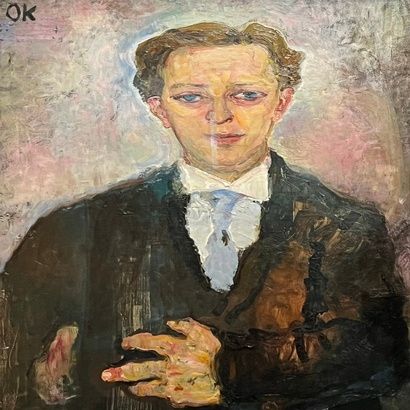Oskar Kokoschka : la psychologie des mains
Hands have always been a privileged expression in the iconography of the ancients and throughout the history of art: hand gestures are like symbols or words referring to complex notions.
The hands play an essential role in Oskar Kokoschka's painting.
The Trance Player representing the actor Ernest Reinhold, dated 1909, a friend of the artist, is displayed at the entrance of the exhibition and it is here that I was captivated by two features of this portrait: the eyes and the hands that resonate.
You will notice that the size of the hands is unprecedented, with four fingers. The artist explores here the psychological aspect of the subject which takes over the reality.
This work will be part of the works seized from German collections in 1937.
A surprising painting is that of Father Hirsch dated 1909.
The character is put forward: observe the position of the hands, oriented towards the inside, a reductive side, in resonance with a greedy look and revealed teeth, not to discover a charming smile, but revealing a character trait that does not seem very happy.
Indeed, Moritz Hirsch was a wealthy Hungarian businessman described as a headstrong and angry man. If the art of portraiture traditionally hides the teeth, Kokoshka reveals them openly, we only see that...
He was accused by the public of caricaturing his models.
For my part, I find this painting full of humor!
This painting will also be confiscated in 1937 and will be presented at the exhibition of degenerate art in 1937 - It should be noted that this exhibition was very successful at the time.
Even in his drawings, the hands are important and immediately express the idea that the artist wanted to convey: this old woman with her back to us, a drawing dated 1907, is the most perfect expression.
Discovering "The hands" as an expression of the complicity of the couple:
this portrait of Hans and Erica Tietze dated 1909 is very strong: Hans' hands in a softness and an intimate determination is close to that of Erica, a hand on the heart and a hand receptive to the extended hand.
Beyond that, the expression of each of them is respected, each represented in a certain introspection, in a hazy but colorful atmosphere, marking the complicity of the couple.
Kokoschka made this painting without having the couple pose together, as if each fragment of the one and the other were intertwined with each other.
Hans and Eric Tietze were a couple of art historians and critics, great supporters of Kokoschka's art and close friends.
A more classical approach to portraiture would be that of Max Schmidt, a posture where, again, the face and hands respond to each other expressing a poised intellectual persona.
The 1910 painting "The Manager" bears witness to the character of the character: eyes lowered, in absolute calm, composed, reassuring as a good manager would be, the hand resting on his chest, a benevolent smile.
Let's go back to the posture of the hands, with this portrait of Herwardt Walden, an air of intellectual displayed, large forehead, glasses, an air of introspection, the hand on the hip proving a certain self-confidence. This portrait was painted during the preparation for the creation of the magazine Der Sturm.
The hands on either side of the body of this young girl coupled with a gaze dreaming of the future in a halo of light, a blue dress in an attitude could recall the portraits of classical virgins?
Homage to the traditional subjects of art history with this Annunciation dated 1911, the hands occupying almost three quarters of the painting in the iconography of the scene.
A posture of enclosure is that of this "prisoner," a painting dated 1914, with his hands crossed and his gaze directed towards an open window, symbol of a coveted freedom and symbol of his inner freedom.
The hands as a symbol of commitment: this painting representing Leo Kestenberg represents the artist with his fists closed in a frontal pose, suggesting the political commitment of the Kerstenbergs, who were involved in the activities of the social democratic movement from 1918.
There are so many more examples to cite, but it might seem redundant.
The best thing to do now is to go to the exhibition, which is, I must say, incomparable in the themes it deals with and in the number of paintings.


